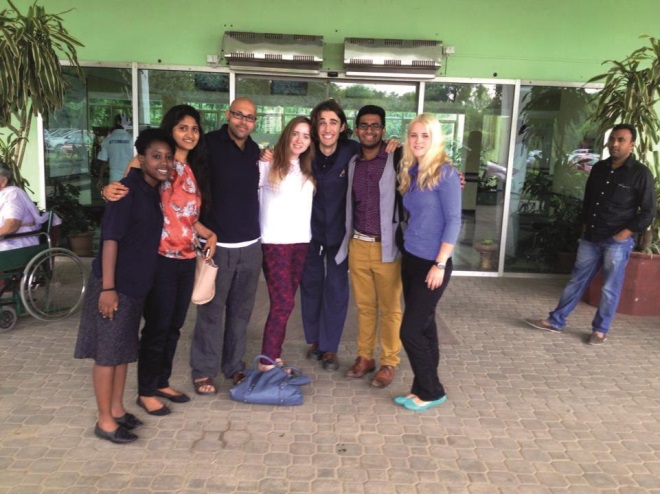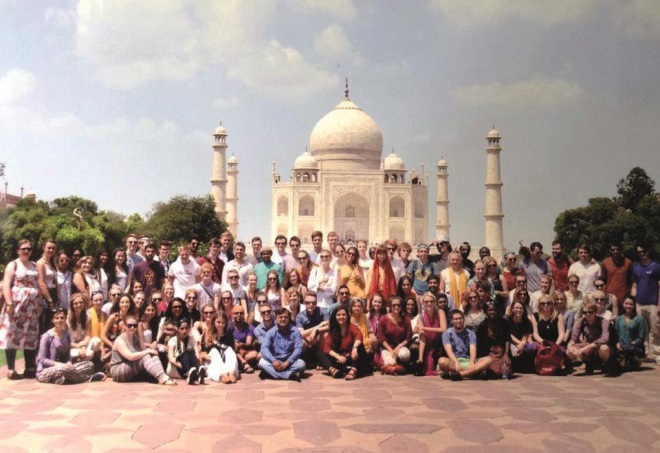
Me (far left) and my colleagues at the Indian Spinal Injury Centre
Since starting my pharmacy degree I have had the passion and enthusiasm to progress and take up opportunities to develop myself further. In order to facilitate this, I applied and was accepted onto the UK-India education and research (UKIERI) Study India Programme and was offered an internship at the world renowned Indian Spinal Injury Centre (ISIC) in 2014. This healthcare internship was ideal for me as a pharmacy student as it gave me a unique insight into the Indian healthcare sector and particularly the role of pharmacists. In addition, the three-week intensive UKIERI programme offered 200 students from the UK an incredible opportunity discover and explore India the best way possible, through learning its rich history and culture.
ISIC is the most advanced spinal injury centre in Asia and has patients from all over the world. During my clinical rotation in the rehabilitation unit I saw patients who had travelled from Nigeria and Iraq. I also visited different departments in the hospital such as pharmacy, assistive technology, surgery and research.
My first rotation was in the pharmacy department. The pharmacy was very busy and there were several pharmacists all working together. Each patient was given verbal directions on how to take their medication rather than given written instructions. Another contrast to the UK was that fridge items were dispensed with an icepack. Similarly to the UK, the pharmacist’s role included dispensing and giving out medication, as well as well as contacting the doctor to substitute out of stock medicines. .
The hospital had its own formulary used for prescribing all medicines required at the hospital and only consultants were allowed to prescribe, and using only the drugs listed in the formulary, except in emergency cases. The hospital had its own hospital manual, which was similar to the standard operating procedures. A ‘crash cart’ defibrillator, cardiac monitor and emergency medicines were available on all hospital departments. Pharmacists were responsible for delivering the restocked crash carts as well as ensuring all medicines were in date.
Other departments
The assistive technology department specialises in devices used to help patients with disabilities to live a more independent life, through increasing and maintaining their functional capabilities. Examples include wheelchairs, ramps, and adapted eating utensils and communication devices. It was in this department that I shadowed an assessment for a patient with a C5 spinal cord injury and even managed to get hands-on experience by learning to construct a wheelchair.
I also spent a day at the rehabilitation unit, one of the largest in Asia, where we observed occupational therapists and physiotherapists. We saw patients suffering from a vast range of conditions such as cervical myopathy, stroke and Guillain-Barre Syndrome (GBS). GBS is a rare condition in which the peripheral nervous system is attacked by the body’s immune system, which can result in muscle weakness and can eventually lead to paralysis. The last day of the internship was spent at the surgical ward where we observed a knee replacement surgery and the surgical removal of a tumour within the spinal cord. This was an unforgettable experience and by far one of the highlights of my internship.
Throughout the week the hospital staff were very welcoming and compassionate. They gave me and the other students the opportunity to really make the most of the time we were there and to get as much experience and knowledge as possible.
Culture

Our visit to the Taj Mahal
The first week of the UKIERI Study India Programme gave all 200 UK students a unique insight into the life of a Delhi college student and we attended exciting lectures from students. In the mornings we embraced Indian culture by attending yoga, Bollywood and Hindi lessons. The evenings were packed with interesting talks and visits. We visited the world historical monuments such as the Lotus Temple, Taj Mahal and India Gate. In the last week we had the chance to explore a different city in India; Mumbai. Our week included understanding the Indian economy during a talk at the Bombay stock exchange, a visit to a rural village and a visit to the largest slum in Mumbai, Dharavi, which helped to break many misconceptions about slums.
Overall, it was a dream to be in such a fascinating, welcoming and optimistic country and my experience in India and at the spinal injury centre was inspirational and unforgettable.
For more information on the programme you can visit www.ukieri.org or email apply@studyindia.co.uk


